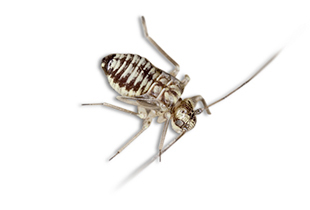

SPECIES: Liposcelis bostrychophila (order Psocoptera)
COMMON NAME: Booklice
SIZE: approx. 1 mm
LIFECYCLE: between the egg and image, there are between 3-8 larval stages. Development occurs during the summer and lasts between 20 and 40 days; at a constant temperature of 27°C and 65% relative humidity the development lasts about 30 days, of which seven are the egg stage. Six to eight generations can be produced in a year. The lifespan of the adult animals ranges from 10 to 12 weeks. the Psocoptera need a high air humidity (from 65% to 95%). It is, however, possible for the creatures to be present for a limited period, (e.g. in dry flour) at values up to about 60%. If the relative humidity falls below 65%, the mortality rate increases dramatically. The number of eggs laid by each female increases with increasing humidity. Thus creating dry conditions slows the population growth of Psocoptera, and can even stop it completely.
FEATURES: the Psocoptera are relatively primitive insects, with small or highly atrophied wings. Adults are only 1-2 mm and are yellowish brown to black. Since the Psocoptera are hemimetabolous, the larvae are very similar to adult animals. They are pale, or sometimes transparent, and their feet always have two segments, even their antennas have only a few segments. Some species have males while others multiply solely by parthenogenesis (i.e. without males).
HABITAT: Psocoptera can multiply rapidly in grains with high water content, in mouldy food stored in humid environments, and in damp attics, factories and homes (even new constructions), rendering grains and other supplies useless as food for humans. Psocoptera also live in mouldy straw, hay and plant hairs, which can then be brought into homes when these materials are used to insulate walls or ceilings, or for filling upholstered furniture and mattresses. If the environments are sufficiently moist to encourage the growth of mould, this can lead to a rapid multiplication of the Psocoptera, which might not have been seen at all beforehand. The Psocoptera then have the run of the house and can penetrate cupboards and food that has been stored there. Even bird nests built on homes can cause an invasion of Psocoptera in homes.
DIET: the range of foods they eat includes dust, layers of mould, to the floury body of cereal grains. Psocoptera probably are unable to attack entire grains of cereals, but must make do with broken grains. Their presence is not characterised by any consistent form of damage. There is an interdependence between invasion of fungi and Psocoptera. Some varieties of Psocoptera feed on fungi, which in turn can spread their spores, ingested by the Psocoptera, in their droppings.
DAMAGE: A major presence of Psocoptera in homes arouses a sense of disgust. The infestation is characterised primarily by the mass of insects flying around, or which have died after pest control measures. Considering (for example) 1000 g of wheat attacked: after fumigation, 1 to 2 grams of Psocoptera may be found. To the above, one must also consider the pollution caused by the dark droppings in the flour, spices or teas. The harm that is caused by their nutrition mostly isn't particularly noticeable as the Psocoptera are feed mostly on mould. However, in cereals with damaged kernel films, it is also possible that both the floury body and the germ itself are completely devoured. Major infestations occur in humid storehouses. Species harmful to food reserves can penetrate through the same through their packing material, due to the small size of their body, via the tiniest cracks and fissures. Furthermore, if the packaging was stored in a humid environment, the insects may already be in the packaging before the food is added. There are, however, so many infestation possibilities for packaged foods, it is almost impossible to establish when the initial infestation of a package bought from the merchant took place. These insects can devour paper affected by fungi. The points at which they have eaten include traces of scraping that are practically invisible. They devour the adhesive layer of stamps and thus decrease their philatelic value. They can wipe out the value of herbaria and insect collections. They will often completely destroy dried plants, as well as small insects. When it comes to larger insects, they limit themselves to the antennae, to the elements of the mouth probes, and to segments of the feet, and they will eat the scales of butterflies. Needles are not a hindrance for them to get at their food.
I want to sterminate itFor the disinfestation of all areas, contact Gallura Disinfestazioni, a company specialized in disinfestation. Contact us for more information!